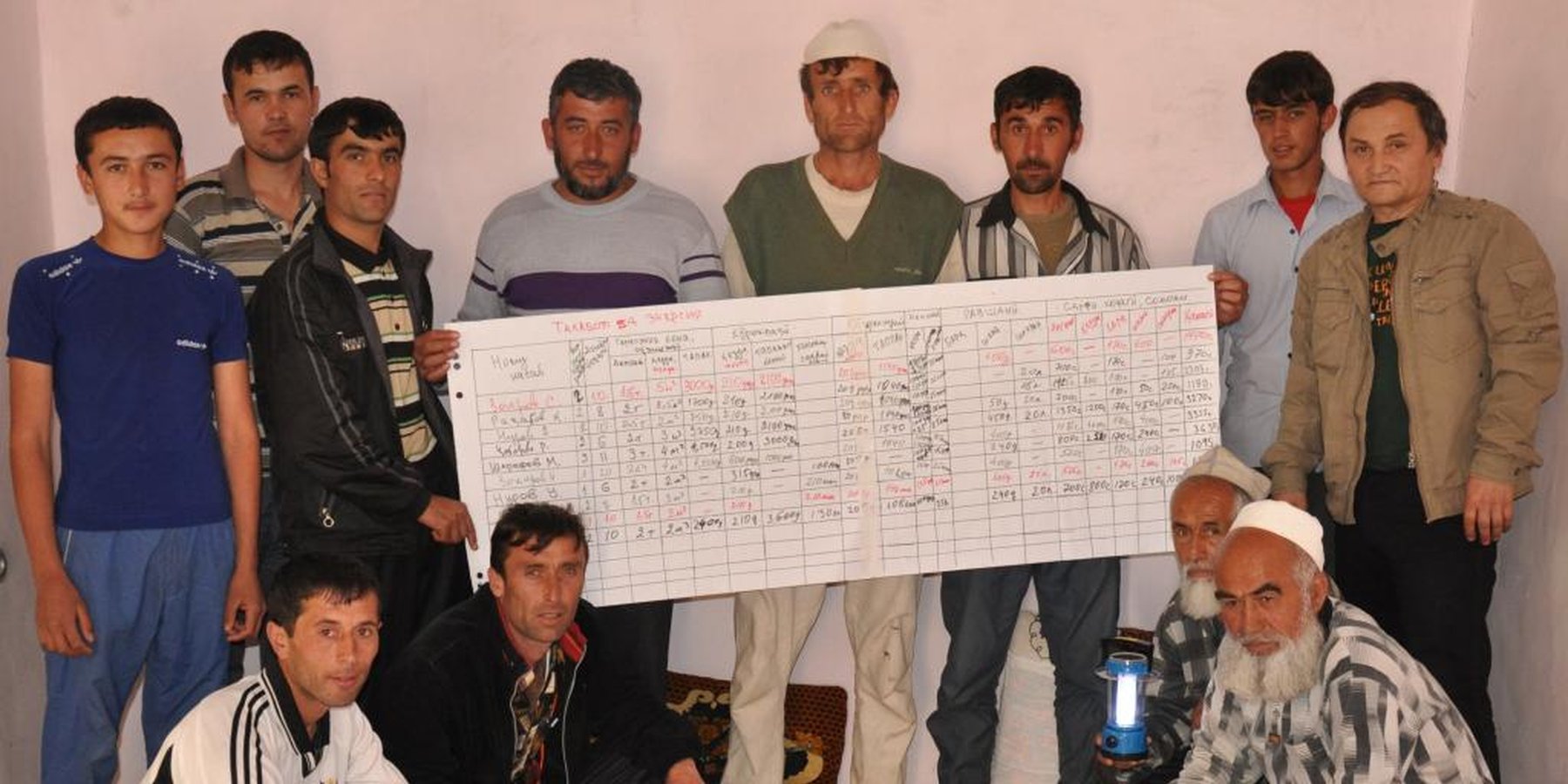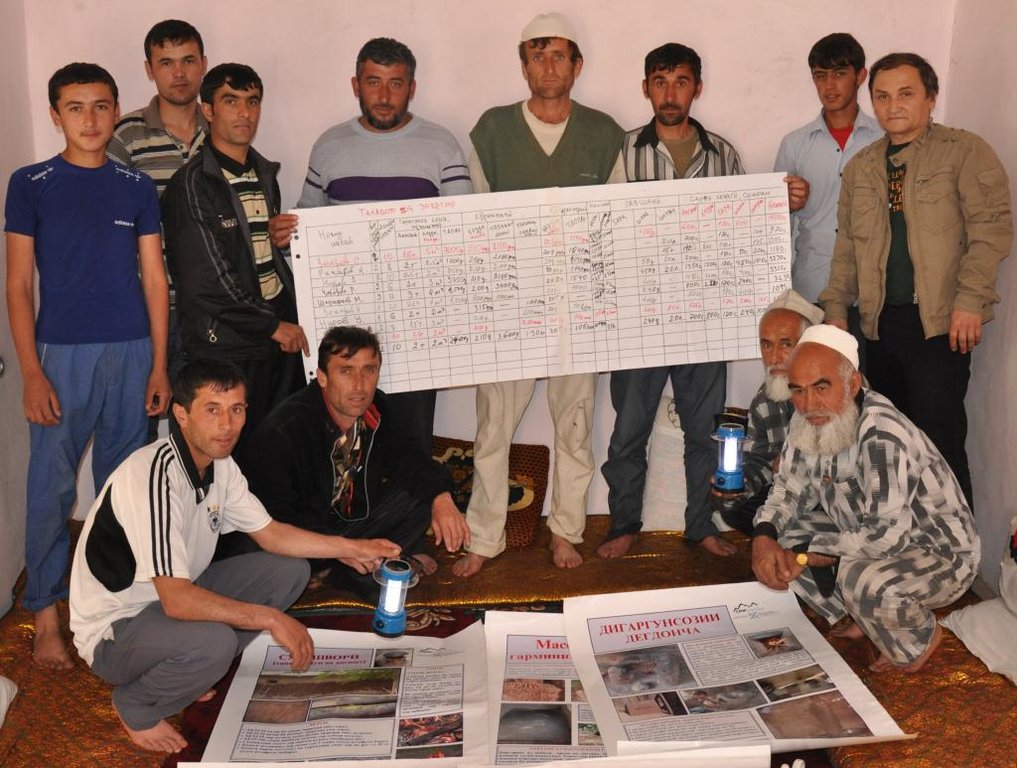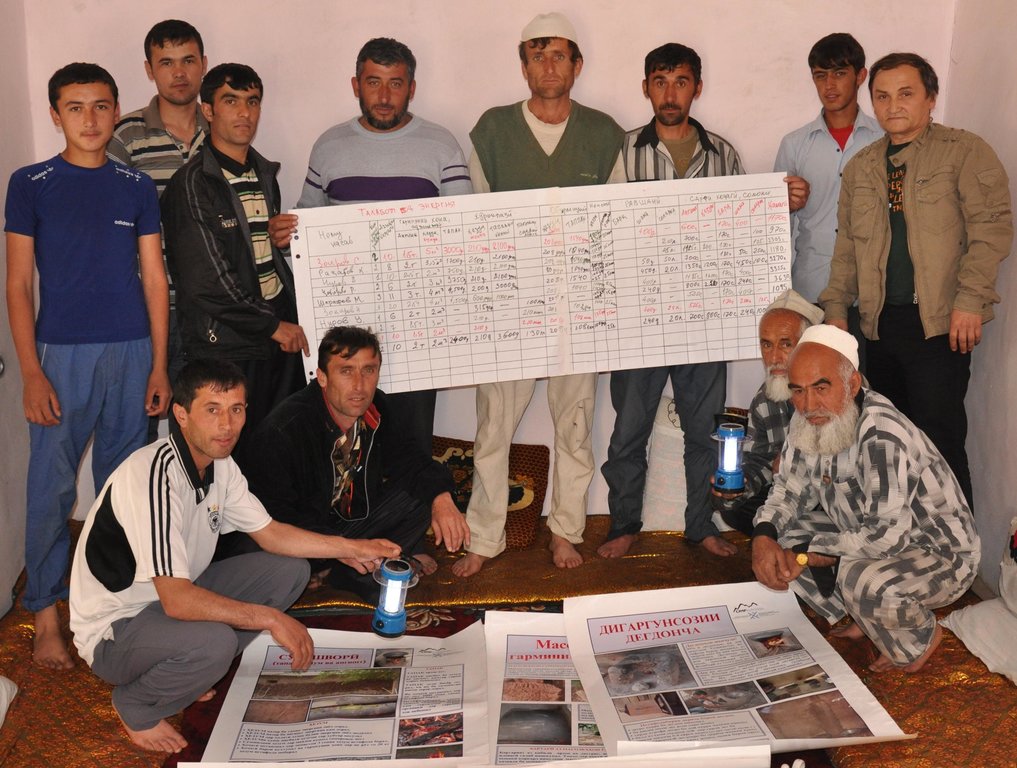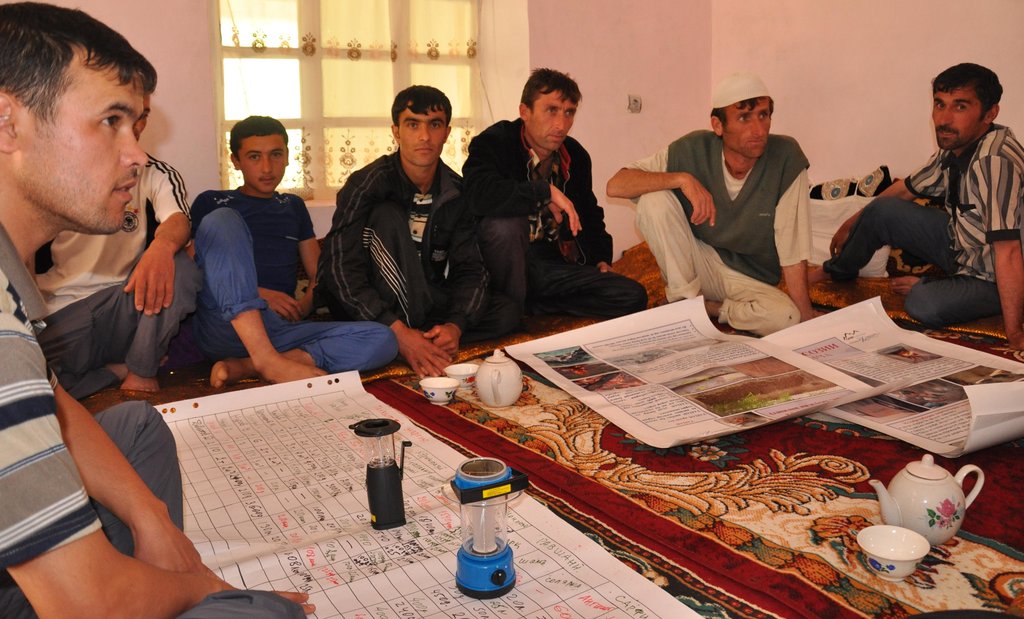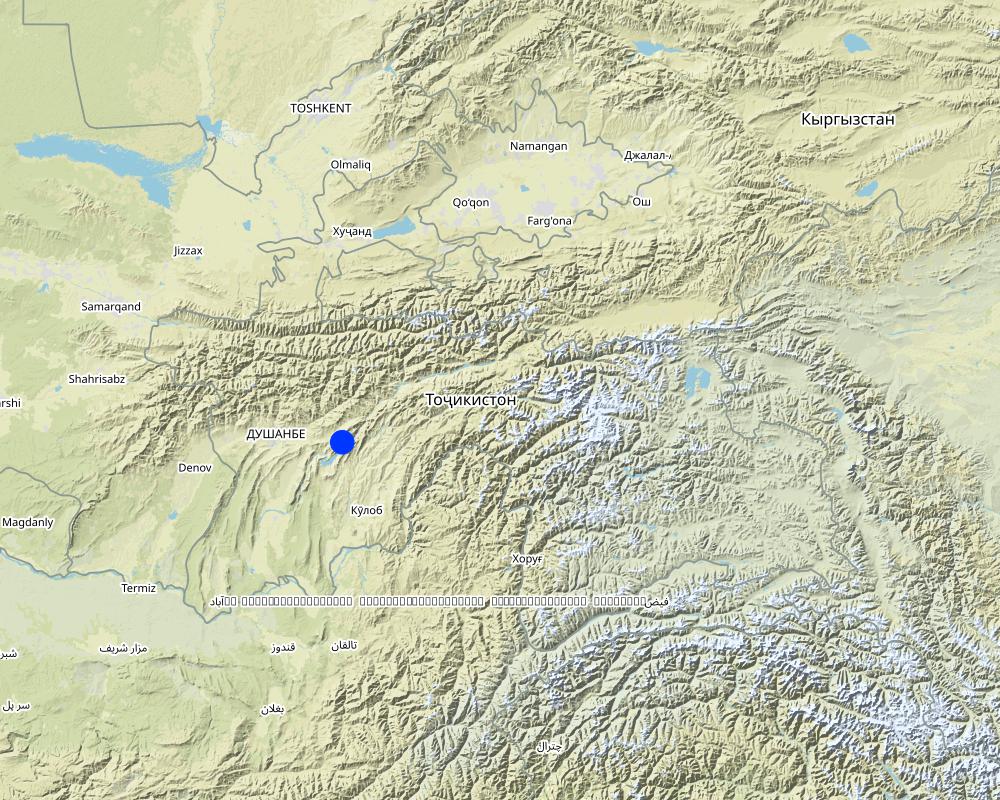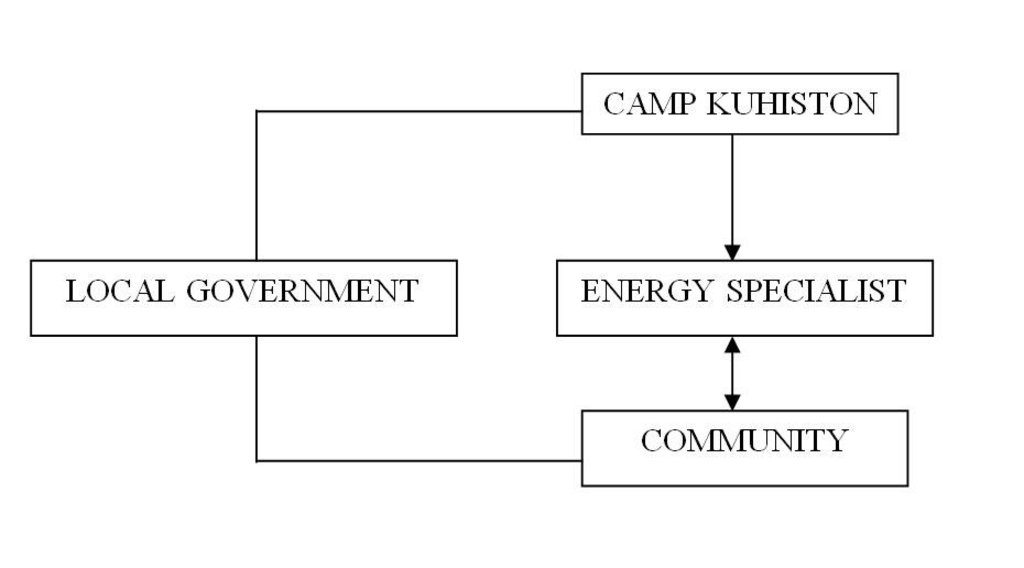Participatory Cost Benefit Analysis for Energy Efficiency Measures [Tayikistán]
- Creación:
- Actualización:
- Compilador: shane stevenson
- Editor: –
- Revisores: David Streiff, Alexandra Gavilano, Joana Eichenberger
approaches_2442 - Tayikistán
Visualizar secciones
Expandir todo Colapsar todos1. Información general
1.2 Detalles de contacto de las personas de referencia e instituciones involucradas en la evaluación y la documentación del Enfoque
Especialista MST:
Pochoev Mirzo
992 44 601 55 05
CAMP Kuhiston
Dushanbe
Tayikistán
Nombre del proyecto que facilitó la documentación/ evaluación del Enfoque (si fuera relevante)
Pilot Program for Climate Resilience, Tajikistan (WB / PPCR)Nombre de la(s) institución(es) que facilitaron la documentación/ evaluación del Enfoque si fuera relevante)
CAMP - Central Asian Mountain Partnership (CAMP - Central Asian Mountain Partnership) - Kirguistán1.3 Condiciones referidas al uso de datos documentados mediante WOCAT
¿Cuándo se compilaron los datos (en el campo)?
25/04/2011
El compilador y la/s persona(s) de referencia claves aceptan las condiciones acerca del uso de los datos documentados mediante WOCAT :
Sí
1.4 Referencia/s al/los Cuestionario(s) de Tecnologías MST
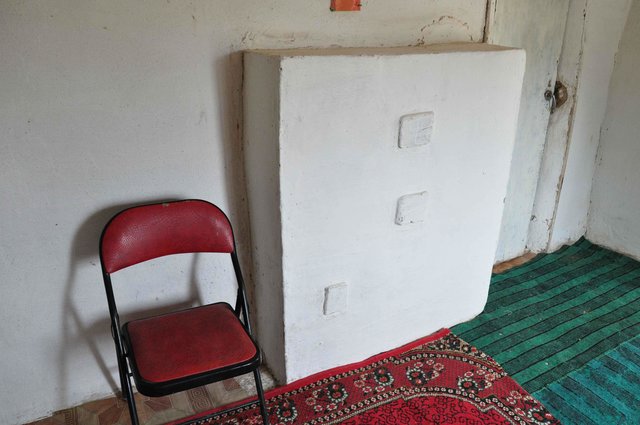
Two Room Stove [Tayikistán]
A brick stove that is built into the existing internal wall, that will heat the two rooms and can be used for cooking.
- Compilador: shane stevenson
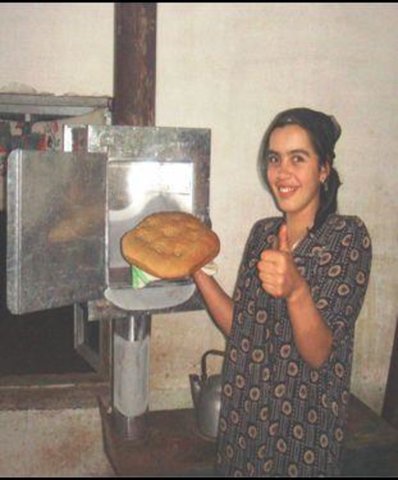
Energy efficiency measures to increase the application of … [Tayikistán]
The implementation of several low cost energy efficiency measures to reduce the amount of organic material used as fuel within rural households.
- Compilador: Daler Domullojonov
2. Descripción del Enfoque MST
2.1 Breve descripción del Enfoque
The use of a cost benefit analysis approach to assess the financial and natural resource needs for energy consumption at community level, and further attribute costs to SLM practices to meet this need, and subsequently improve rural livelihoods.
2.2 Descripción detallada del Enfoque MST
Descripción detallada del Enfoque MST:
Aims / objectives: To collate quantitative data on the amount of energy used within the community in terms of financial expenditure and natural resource use. Through the use of a participatory workshop the attendees determine which natural resources are being utilised, in the form of wood, bush and organic materials. The objective is to use this quantitative data to encourage through cost benefit demonstrations, the implementation of Sustainable Land Management technologies to reduce the amount of natural resources exploited, and the expenditure on energy consumption.
Methods: An energy specialist organises a community based workshop with up to 15 participants. In the 2-3hr workshop the participants complete, under guidance, a pre prepared flip chart on energy use (electric, tapak, wood, coal, brush). The information is collected in financial expenditure and weight. Once the energy assessment is completed a subsequent discussion is encouraged on how to more effectively meet this need at a community level. The moderator also takes this oppoprtunity to demonstrate several technologies including solar lights, improved stove design, thermal insulation, and the development of energy forests. The information is collated and used as a baseline assessment for evaluation of implemented technologies.
Stages of implementation: The stages of implementation are relatively straight forward. First you must select the community that you wish to work in, and inform a community mobiliser, in this case the head of the village that you wish to conduct a 2-3 hr workshop for up to 15 participants, and that the participants must be the person in the households who is responsible (or has knowledge of) the energy use within the household. The moderator prepares a flip chart with a table of fuel types used in the village and uses this as the basis of the workshop to extract information on energy use within the community. Once the information is collated, a discussion is encouraged to review the information and devise means by which this amount can be reduced. The moderator then takes this opportunity to demonstrate several low cost energy efficiency measures that may appeal to the community.
Role of stakeholders: The community are expected to attend the workshop, engage in active discussions on their energy use and ways in which it can be reduced. The workshop needs to be supported by the local government, this provides gravitas, and a platform to launch the approach in other communities. The final stakeholder is the implementer, in this case a local NGO who organises the workshop, demonstrates the technologies and provides ongoing support during the implementation of the technologies.
Other important information: It is important to understand the spending habits of the participants, if they are used to spending on a day to day basis and not used to financial planning, it is important to recognise this fact in the implementation of the technology.
2.3 Fotos del Enfoque
2.5 País/ región/ lugares donde el Enfoque fue aplicado
País:
Tayikistán
Región/ Estado/ Provincia:
RRS
Especifique más el lugar :
Nurobod, Shaftuti Bolo
Map
×2.6 Fechas de inicio y conclusión del Enfoque
Indique año del inicio:
2011
Año de conclusión (si el Enfoque ya no se aplica):
2012
2.7 Tipo de Enfoque
- proyecto/ basado en un programa
2.8 Propósitos/ objetivos principales del Enfoque
The Approach focused mainly on SLM with other activities (Energy Conservation)
There were two main objectives to this approach, the first was to raise awareness on energy use with respect to types of energy, cost and accessibility, and to use this as a platform for encouraging the implementation of low cost energy efficiency measures in the community. The second was to collate baseline data to allow an assessment of how the implemented technologies impacted on energy (and by association natural resources) use and how the expenditure and amounts were reduced in real terms.
The SLM Approach addressed the following problems: This approach was designed to make the participants evaluate and assess the amount of money, time and effort that goes into meeting their energy needs. It is also a clear and precise way to collate information on the amount of natural resources that are been used to meet this need. These natural resources can be in the form on bushes, wood, dung, cotton sticks etc. These resources are being redirected from other purposes such as construction, but also as natural fertilisers, mulch and compost. This directly impacts on agricultural production, household finance and ultimately livelihoods. The reduction in resource use can reduce the risk of conflicts between villages, and reduce pressure on natural resources allowing them to rejuvenate, and increase soil fertility and quality.
2.9 Condiciones que facilitan o impiden la implementación de la/s Tecnología/s aplicadas bajo el Enfoque
normas y valores sociales/ culturales/ religiosos
- impiden
Rural communities emerging from the soviet system have very low business awareness. Even when there are seemingly obvious savings to be made in finance and natural resources there is a lack of appreciation of the potential savings that could be made.
Treatment through the SLM Approach: Discussion on the issue of savings in time, money and resources helps promote better understanding. The concept of pay back had to be repeatedly explained.
marco de trabajo legal (tenencia de tierra, derechos de uso de tierra y agua)
- facilitan
- impiden
carga de trabajo, disponibilidad de mano de obra
- impiden
There are times of year when the village participants are otherwise distracted by sowing seeds, harvesting, Ramadan etc.
Treatment through the SLM Approach: The most effective time would be at the end of the winter period when resources are scarce, money constraints are more apparent and energy use is a household priority issue.
otros
- impiden
In many of the households the men are working away in Russia. This leaves the women in charge of the household, however, many of the energy costs are organised by the men before they leave or on their return.
Treatment through the SLM Approach: Many of the labour migrant leave in the springtime, therefore it would be more effective to organise the workshops at the end of the winter before they leave.
3. Participación y roles de las partes interesadas involucradas
3.1 Partes interesadas involucradas en el Enfoque y sus roles
- usuarios locales de tierras/ comunidades locales
A representative from each household in the community was involved.
Women hold a traditional role in the society and did not participate in the workshops. The men pay all the bills and see their role as that of the provider for the family.
The entire village suffers from mass labour migration, with nearly all households reliant upon remittances from Russia.
- especialistas MST/consejeros agrícolas
International support and finance was provided for this approach, however, the questionnaire was developed in collaboration between national and international staff to ensure relevance and applicability to the context.
- ONG
CAMP Kuhiston
Si varias partes interesadas estuvieron involucradas, indique la agencia principal:
CAMP Kuhiston
3.2 Involucramiento de los usuarios locales de tierras/ comunidades locales en las distintas fases del Enfoque
| Involucramiento de los usuarios locales de tierras/ comunidades locales | Especifique quién se involucró y describa las actividades | |
|---|---|---|
| iniciación/ motivación | ninguno | |
| planificación | ninguno | |
| implementación | auto-movilización | they were active in the participation in the workshops and the collation of data. |
| monitoreo y evaluación | apoyo externo | Active in providing follow-up data to evaluate the success of the project. |
| Research | ninguno |
3.3 Flujograma (si estuviera disponible)
Descripción:
The project employs an energy specialist to conduct a participatory workshop. The process is supported by the local government.
Autor:
S. Stevenson (CAMP Kuhiston, Dushanbe)
3.4 La toma de decisiones en la selección de Tecnología(s) MST
Especifique quién decidió la selección de las Tecnología/ Tecnologías a implementarse:
- principalmente usuarios de tierras con el apoyo de especialistas MST
Explique:
The participants are presented with a range of potential energy efficiency technologies such as stove adaptation, thermal insulation by experts, however, it is the participants decision as to which technologies are the most appropriate for their communtiy, and how they can implemented.
Decisions on the method of implementing the SLM Technology were made by mainly by land users supported by SLM specialists. One technology involved the adaptation of traditional cooking stoves; demonstrations were provided however, the mechanisms for securing the materials and ensuring the entire village implemented the technology were up to the discretion of the participants.
4. Apoyo técnico, fortalecimiento institucional y gestión del conocimiento
4.1 Construcción de capacidades / capacitación
¿Se proporcionó la capacitación a usuarios de tierras/ otras partes interesadas?
Sí
Especifique quién fue capacitado:
- usuarios de tierras
Si fuese relevante, también especifique género, edad, estatus, etnicidad, etc.
The initial training was for all the households in the village, however, only the men attended due to the religious and cultural position of the region.
Forma de capacitación:
- cursos
Temas avanzados:
The training included raising awareness on stove adaptation, indoor two room stove construction, solar power, and low cost thermal insulation for rooms.
4.2 Servicio de asesoría
¿Los usuarios de tierras tienen acceso a un servicio de asesoría?
No
4.3 Fortalecimiento institucional (desarrollo institucional)
¿Se establecieron o fortalecieron instituciones mediante el Enfoque?
- sí, moderadamente
Especifique el nivel o los niveles en los que se fortalecieron o establecieron las instituciones:
- local
Especifique el tipo de apoyo:
- financiero
Proporcione detalles adicionales:
The Jephcott Foundation financed local NGO CAMP Kuhiston to implement the approach.
4.4 Monitoreo y evaluación
¿El monitoreo y la evaluación forman parte del Enfoque?
Sí
Comentarios:
socio-cultural aspects were regular monitored by project staff through observations; indicators: Observations of participants understanding of economic benefits.
management of Approach aspects were ad hoc monitored by None through observations; indicators: international staff monitor the set up of the workshops and levels of participation.
There were few changes in the Approach as a result of monitoring and evaluation: The timing of the workshops (i.e the time of year) will be changed to the end of the winter when energy use is more of a priority issue, e.g. cold weather, poor electric supply, lack of easily accessible natural resources
There were no changes in the Technology as a result of monitoring and evaluation: None
4.5 Investigación
¿La investigación formó parte del Enfoque?
Sí
Especifique los temas:
- sociología
- economía/ marketing
Proporcione detalles adicionales e indique quién hizo la investigación:
CAMP Kuhiston collated data on energy usage and by association natural resource use. In addition to the participatory workshop CAMP conducted a household questionnaire to assess the suitability of different energy efficiency technologies, and the social vulnerability of the inhabitants, to identify the most effective households to implement energy saving activities.
Research was carried out on-farm
5. Financiamiento y apoyo material externo
5.1 Presupuesto anual para el componente MST del Enfoque
Si no se conoce el presupuesto anual preciso, indique el rango:
- < 2,000
Comentarios (ej. fuentes principales de financiamiento/ donantes principales):
Approach costs were met by the following donors: international non-government (Jephcott Foundation, UK): 100.0%
5.2 Apoyo financiero/material proporcionado a los usuarios de tierras
¿Los usuarios de tierras recibieron financiamiento/ apoyo material para implementar la Tecnología/ Tecnologías? :
No
5.3 Subsidios para insumos específicos (incluyendo mano de obra)
- equipo
| Especifique qué insumos se subsidiaron | En qué grado | Especifique los subsidios |
|---|---|---|
| Posters and stationery | totalmente financiado | |
- construcción
| Especifique qué insumos se subsidiaron | En qué grado | Especifique los subsidios |
|---|---|---|
| Metal sheets, demonstration material | totalmente financiado | |
Comentarios:
Metal sheets and some other basic materials were provided for the demonstration adaptation of the outdoor cooking stoves.
5.4 Crédito
¿Se proporcionó crédito bajo el Enfoque para actividades MST?
No
5.5 Otros incentivos o instrumentos
¿Se usaron otros incentivos o instrumentos para promover la implementación de Tecnologías MST?
Sí
Si fuera el caso, especifique :
The Jephcott Foundation financed local NGO CAMP Kuhiston to implement the approach.
6. Análisis de impacto y comentarios de conclusión
6.1 Impactos del Enfoque
¿El Enfoque ayudó a los usuarios de tierras a implementar y mantener Tecnologías MST?
- No
- Sí, un poco
- Sí, moderadamente
- Sí, mucho
The extent to which it will reduce the amount and type of natural resource use will be re assessed at the end of the project. It is estimated that there will be a 20% reduction.
¿El Enfoque empoderó a grupos en desventaja social y económica?
- No
- Sí, un poco
- Sí, moderadamente
- Sí, mucho
The approach was implemented in a socially disadvantaged area.
Did other land users / projects adopt the Approach?
- No
- Sí, un poco
- Sí, moderadamente
- Sí, mucho
Did the Approach lead to improved livelihoods / human well-being?
- No
- Sí, un poco
- Sí, moderadamente
- Sí, mucho
The stove adaptation should lead to a 10-20% reduction in natural resources used for cooking, and the solar lights could make a $100/year saving.
Did the Approach help to alleviate poverty?
- No
- Sí, un poco
- Sí, moderadamente
- Sí, mucho
It should help reduce spending on energy, dependence on natural resources, and increase the amount of organic materials for agricultural purposes.
6.2 Motivación principal del usuario de la tierra para implementar MST
- incremento de la renta(bilidad), proporción mejorada de costo-beneficio
The approach is designed to highlight to households how much of their income they spend on energy.
- prestigio, presión social/ cohesión social
Social pressure ensured all the households participated.
- well-being and livelihoods improvement
Improvement in living conditions and saving of finance and natural resources.
6.3 Sostenibilidad de las actividades del Enfoque
¿Pueden los usuarios de tierras sostener lo que se implementó mediante el Enfoque (sin apoyo externo)?
- incierto
Si respondió no o incierto, especifique y comente:
The participants will be encouraged to re-assess their natural resource use in the following year, and hopefully instigate their own measures to tackle the issue.
6.4 Fortalezas/ ventajas del Enfoque
| Fuerzas/ ventajas/ oportunidades desde la perspectiva del usuario de la tierra |
|---|
| Quick and simple way to put an economic cost on fuel use. |
| Fuerzas/ ventajas/ oportunidades desde la perspectiva del compilador o de otra persona de referencia clave |
|---|
| The approach needs minimal resources and is relatively easy to implement. (How to sustain/ enhance this strength: It would be easy to replicate and easy to teach others how to undertake the approach.) |
| It makes participants evaluate what they need to run their households, and puts an economic and natural resource value on the process. |
| It helps focus the participants on how much time, effort and money are being used to run their household. (How to sustain/ enhance this strength: To follow up, to see how effective the implementation of the technologies was in reducing their energy needs.) |
| The scope of the level of participation is flexible and can be adapted to the contexts. It allows for direct comparison for before and after the implementation of the technology. (How to sustain/ enhance this strength: It could be further developed to put an economic value on SLM technologies.) |
6.5 Debilidades/ desventajas del Enfoque y formas de sobreponerse a ellos
| Debilidades/ desventajas/ riesgos desde la perspectiva del compilador o de otra persona de referencia clave | ¿Cómo sobreponerse a ellas? |
|---|---|
| It requires participants to have good quality data available to be effective. | Complete follow up visits to households to check data quality. |
7. Referencias y vínculos
7.1 Métodos/ fuentes de información
- visitas de campo, encuestas de campo
- entrevistas con usuarios de tierras
Vínculos y módulos
Expandir todo Colapsar todosVínculos

Two Room Stove [Tayikistán]
A brick stove that is built into the existing internal wall, that will heat the two rooms and can be used for cooking.
- Compilador: shane stevenson

Energy efficiency measures to increase the application of … [Tayikistán]
The implementation of several low cost energy efficiency measures to reduce the amount of organic material used as fuel within rural households.
- Compilador: Daler Domullojonov
Módulos
No se hallaron módulos


